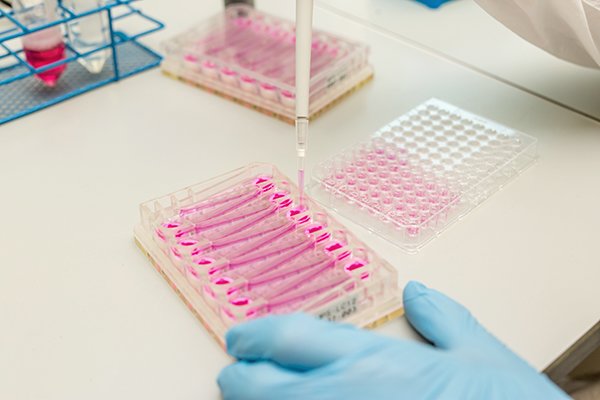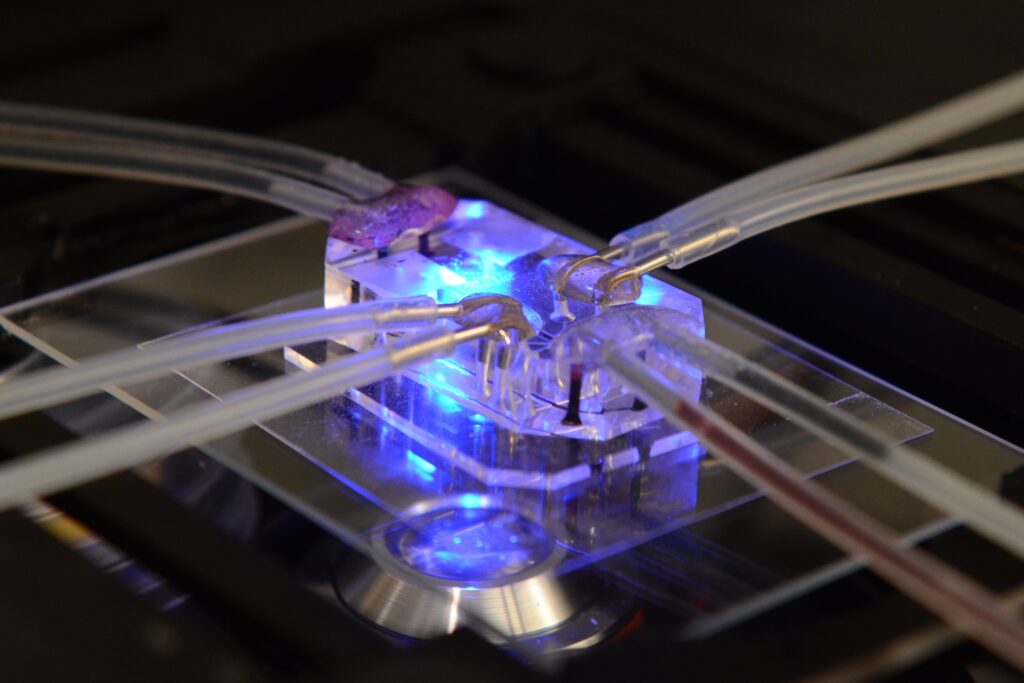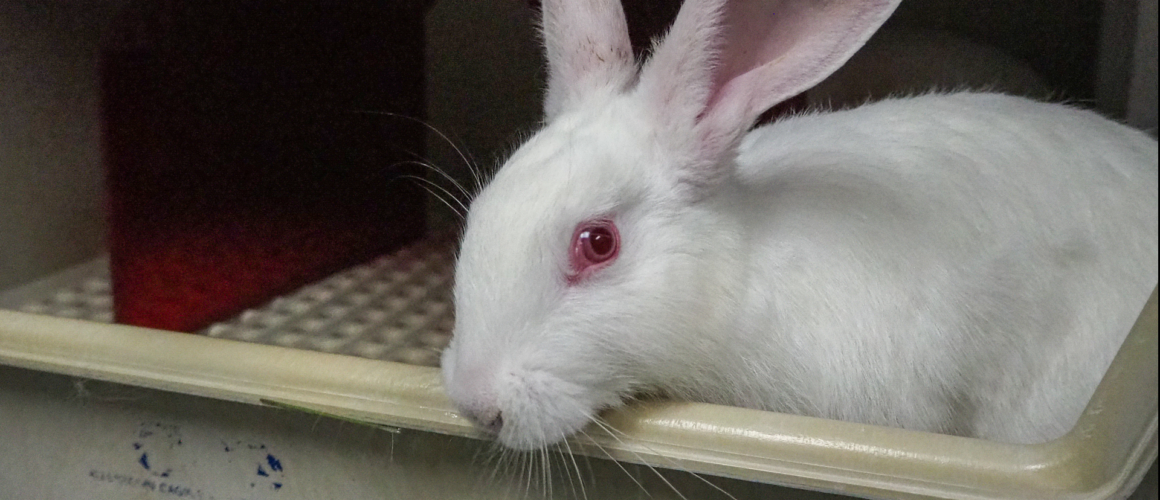Help us to call on the Australian Government to dedicate funding towards animal-free research.
"Australia has comparative global strengths in non-animal methods for several organ systems likely to disrupt the status quo about the use of animal models over the next 15 years.” (1)
CSIRO, 'Non-Animal Models' report, 2023
Using animal-free methods of research is better for humans, better for animals, more cost-effective (1, 2), and better for the environment (3). Despite Australia’s commitment to the application of the 3Rs principles (4) of replace, reduce, and refine, Australia has made no specific funding commitment. With growing concern within the research community that animal studies are contributing to failures in translational research (5), this is an area which requires urgent investment.
Update:
In July 2024, the New South Wales Government announced $4.5 million to reduce and replace the use of animals in medical research. This initiative will fund the establishment of the Non-Animal Technologies Network (NAT-Net), bringing together top researchers and institutions at the University of NSW, Victor Chang Cardiac Research Institute, University of Newcastle, University of Sydney, and University of Technology Sydney.



Australia is missing an opportunity to replace animal use in medical research
A majority of Australians are supportive of the use of alternatives to animals for medical research purposes. The Australian & New Zealand Council for the Care of Animals in Research and Teaching (ANZCCART) revealed that in Australia during the Covid-19 pandemic (July 2022), “there was overwhelming support for looking into alternatives to using animals in scientific research” (6).
Approximately 90% of drugs found to be safe and effective in preclinical research, of which animal testing is currently an expected requirement, fail to make it to human clinical use (7). This represents a significant amount of Australia’s $1.4 billion clinical trials sector (1). In contrast, investing in the development and application of contemporary animal-free models of research may contribute an additional $1.28 billion from organoids and $310 million from organs-on-a-chip to the Australian sector (1).
The CSIRO states that, “setting Australia on a path towards these opportunities would require actioning the [CSIRO report] recommendations within five years [from 2023].
While there are some non-government animal-replacement or 3Rs funding schemes in Australia, and some Australian funding bodies do fund research projects utilising animal-free technologies (8), there is no specific government funding for the development and validation of animal-free methods and there is concern that the current systems of application review mean that those applications do not stand a realistic chance of success, with researchers communicating that the application review process is “deeply flawed” (9). Therefore, the only way such applications would succeed through the system would be for dedicated funds being set aside specifically for this area of research.
We need this both to reduce animal suffering in labs and also to ensure that Australia is a pioneer at the forefront of developing new animal-free technologies which will be more likely to result in clinical application.
Watch an AFSA supporter webinar presentation on the funding landscape for non-animal methods in Australia.
Overseas Examples of Government Funding
Around the world, a number of government-funded initiatives are addressing the need to develop and validate animal-free methods of research:
- In 2025, the US National Institutes of Health (NIH) announced a major commitment to transitioning away from animal research in favour of innovative, human-based science.
- In 2024, the US National Institutes of Health (NIH) established the Complement Animal Research In Experimentation (Complement-ARIE) program to fund the development, standardisation, validation and use of non-animal methods.
- In 2024, the US National Center for Advancing Translational Sciences has established new centres to strengthen the use of organ-on-a-chip, or tissue chip, technology to develop drugs and reduce the need for animals in research with a US $31M investment.
- Announced in 2024, the Dutch National Growth Fund will invest £214.5M in a new centre for animal-free biomedical testing.
- In 2004, an independent UK organisation established the National Centre for the Replacement, Refinement and Reduction of Animals in Research (NC3Rs), with a commitment to government funding doubled from £10M to £20M for the 2024 financial year.
- In 1997, the US established the Interagency Coordinating Committee on the Validation of Alternative Methods (ICCVAM).
- In 1991, the European Centre for the Validation of Alternative Methods (ECVAM) was established.
- In 1989, the German Federal Institute for Risk Assessment developed the Centre for Documentation and Evaluation of Alternative Methods to Animal Experiments (ZEBET) to develop alternative methods based on the 3Rs principle, supports research projects in this field and advises authorities on methods that can replace or reduce the number of animal experiments.
Take Action!
Business Case for Funding Non-Animal Methodologies
Considering the public interest in ethical treatment of animals, the likelihood of animal-free alternatives providing more beneficial outcomes for public health and the legislation itself requiring adherence to the 3R’s, Australia’s peak funding bodies are duty-bound to allocate meaningful financial support to the development of animal-free models.
The use of animals in research is, according to the code, for cases where no alternative exists, but alternatives are unlikely to be adequately adopted without support for the development of animal-free based scientific testing. Australian researchers therefore need dedicated funds earmarked specifically for the development of animal-free methods of research – as occurs in other nations.
Australian federal, state and territory governments should now be making a commitment to fund research into seeking alternatives to animal use – as is already the case in other countries.
Environmental Impact
Animal-based research generates additional environmental costs, compared to non-animal based research, which is often overlooked when considering the impact of animal research. These additional environmental costs also reflect financial costs. For example, to ensure the comfort and required maintenance of animal environments, research laboratories require significant amounts of energy, up to ten times more per square meter than common office buildings (10).
Depending on the level of biosecurity at a facility, there may be further energy and infrastructure requirements (11) to maintain a strict enclosed laboratory, including power supply and exhaust systems (12), in addition to increased air handling units, advanced cleaning procedures, and containment amenities (13). Bio secure laboratories may also have the requirement of being a building independent of others in the facility with independent power and airflow systems.
Reducing the need for additional power, exhaust systems, air handling units, cleaning, and containment, will reduce the cost of maintaining animal-based research facilities and allow for more funding to be spent on human-relevant health research.
CSIRO Non-Animal Models Report
A report from the team at CSIRO Futures examines the potential of animal-free models in preclinical research and the actions Australia will need to take to pursue their use. The report states, “The complexity of non-animal models is rapidly increasing, equating to or surpassing the performance of traditionally used animal models in several applications. Due to their enhanced biological relevance, non-animal models can increase productivity and reduce costs by identifying unsuitable medical products earlier in development and re-investing savings in more promising candidates.”
Australia has existing infrastructure which can support a rapid transition to animal-free research. One recent example is the Australian Organoid Facility (AOF) which was established at the University of Queensland’s (UQ) Australian Institute for Bioengineering and Nanotechnology in place of part of UQ’s animal research facility. And Greg Williams (Associate Director) and Laura-Anne Thomas (Strategy Manager), of CSIRO Futures who compiled the Non-Animal Models report, highlighted Schott Minifab, “an international biotech and medical device company with Australian roots, which has successfully established scaled production of non-animal model components in Australia for domestic and export markets.”
...for me, as a researcher, if we apply for funding overseas the models are accepted. If I apply for NHMRC funding, I get a comment, "You need an in vivo model. You cannot progress any work because you need an in vivo."
Professor Wojciech Chrzanowski
The Current Response to Funding Allocation
The (NHMRC) National Health and Medical Research Council Act 1992 defines ‘research’ as including “…the laboratory-based or clinical study, or group or community-based study of the causes, treatment and prevention of human diseases and also includes dental research.” In responses to Animal-Free Science Advocacy supporters* elected government representatives have stated that the “NHMRC is not able to provide direct funding for the development and validation of non-animal research methods.” This is said to be due to the restrictions on the endowment fund from which funds are drawn.
In 2020, Greens Senator Mehreen Faruqi asked the Minister representing the Minister for Health if research into the use of alternatives meets the NHMRC definition, to which they replied, “As an inclusive definition, it contemplates that a wider range of activities than set out in the definition will be considered as medical research. Animal experimentation in medical research is directed to the study of the causes, treatment and prevention of human disease. Research into the use of alternatives to animal experimentation is also research that is ultimately directed to these purposes.”
The NHMRC webpage on The 3Rs states that “Applications to NHMRC schemes can focus on the development and validation of models, methods, tools and methodologies to replace, reduce or refine animal use.” Applications for this funding are included under the general grant program scheme criteria.
Whilst funding into the development and validation of non-animal research methods is an option within existing broader NHMRC grants, there is no designated funding unlike in other regions.
In 2022, NHMRC grants that included research that proposed the use of animals were valued at a total of $277.8 million. In 2023, NHMRC grants that included research that proposed the use of animals were valued at a total of $242.4 million (14).
* In communication with Animal-Free Science Advocacy
While other nations forge ahead in the area of alternatives research, Australia is missing an opportunity to excel in clinical translation
References
1. www.csiro.au/en/work-with-us/services/consultancy-strategic-advice-services/csiro-futures/health-and-biosecurity/non-animal-models
2. https://animalfreescienceadvocacy.org.au/wp-content/uploads/2022/08/Business-Case-for-Alternatives-August-22.pdf
3. https://animalfreescienceadvocacy.org.au/issues/environmental-impact/
4. www.nhmrc.gov.au/research-policy/ethics/animal-ethics/3rs
5. Marshall LJ, Bailey J, Cassotta M, Herrmann K, Pistollato F. Poor Translatability of Biomedical Research Using Animals — A Narrative Review. Alternatives to Laboratory Animals. 2023;51(2):102-135. doi:10.1177/02611929231157756
6. https://anzccart.adelaide.edu.au/ua/media/664/attitudes-animal-research-survey-report2.pdf
7. www.nzavs.org.nz/the-issue/the-problems/animal-testing-fails-over-90-of-the-time
8. www.arc.gov.au/funding-research/funding-outcome/grants-dataset
9. www.parliament.nsw.gov.au/lcdocs/other/17595/Answers%20to%20SuppQ%20-%20MAWA%20-%20Received%2019%20August%202022.pdf
10. http://www.researchgate.net/publication/28938753Maintaining_quality_and_reducing_energy_in_research_animal_facilities
11. frackinginquiry.nt.gov.au/?a=424268
12. www.advancetecllc.com/classifications/bsl-bio-safety-level
13. www.mdpi.com/2076-3298/1/1/14
14 https://www.aph.gov.au/api/qon/downloadattachment?attachmentId=74eaa761-0c52-46e3-bf01-e0c8a1ae82b0
Hero Image: Roger Kingbird / We Animals Media, © Copyright We Animals Media 2024. New Zealand white rabbits are by far the most common rabbit breed used in research, toxicology and testing. Typically pair-housed in a laboratory setting, this rabbit sits alone in a caged tray and remains deprived of the ability to engage in their natural behavior.



